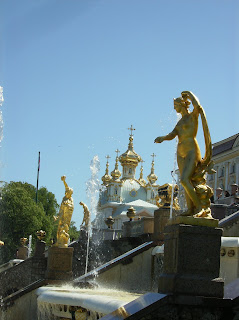Our departure to the U.S. for our month-long visit is less than two weeks away. We are working on things to get ready for that, like the prayer cards that Amanda recently posted as well as a video that unfortunately we have been unsuccessful in uploading here so far. A more relaxed summer schedule has been nice (although it was punctuated by some unwanted excitement earlier this week when we found out that someone had stolen our debit card information and attempted to route some money to the Ukraine. Thankfully our bank caught it and we have been able to work it out, but I send a sincere evil eye to the anonymous villain who did this), and continues to give us a chance to do things that we wouldn't have time to do during the school year.
After our trip to Tsarkoe Selo a few weeks ago, this week Amanda and I decided to go to the town of Schlisselburg and visit its ancient fortress. Our friends Jarod, Christina, and Katya came with us, making for a great group of traveling companions. Once again, we took an elektrichka (communter train), and it took a little over an hour to reach Schlisselburg. The town is located at the very bottom of Lake Ladoga, the enormous freshwater lake that is the source of the Neva River that flows through St. Petersburg. The fortress sits at the head of the Neva, guarding the entry into Lake Ladoga from the South.
The Oreshek fotress in Schlisselburg dates back to the early 1300s and has played a role in many significant moments in Russian history, including being the site of a peace treaty between Sweden and the ancient Russian state of Novgorod in 1323, bring lost to Sweden once more and recaptured by Peter the Great in the Great Northern War (1700-1721), serving as a prison for important political prisoners (including Tsar Ivan VI, members of the Decemberists uprising, the assassins of Alexander II, and Alexander Ulyanov, the older brother of Lenin who was executed in the fortress for his role in a plot to kill the Tsar). The fortress was also an important link in the defense of St. Petersburg (then Leningrad) during World War II, and suffered extensive artillery and bombing attacks from the Germans but did not fall to the Nazis.
In order to reach the fortress you need to take a boat across the water. Once inside, there are numerous memorials, passageways, and buildings to go through. Several of the structures in the fortress are in states of semi-ruin, reflecting significant damange from the Second World War as well as general disrepair I suspect (although reconstruction work on one wall section and tower is currently in progress).
We took lots of photographs, and I'll place comments under them to explain what all there is to see in Oreshek.

The fortress as seen from standing on the shore across from it on the western side (click on it to enlarge it and bring it into sharper relief).

Amanda, Katya, and Christina on the dock waiting for the boat with the fortress behind them.

The main entrance into the fortress.

Amanda walking through the main entrance.

A crumbling portion of the wall on the inside of the fortress.

The interior of the fortress as seen from on top of the portion of the wall we were allowed to climb.

The remains of the church that stood in the center of the fortress.

Inside of the ruins of the church is a memorial to the soldiers who fought to defend the fortress during World War II.

Inside one of the prisons of the fortress. It was here in this prison that many of the conspirators in the plot that led to the assassination of Alexander II were held.

This tower is the only part of the current fortress that was built by the Swedes. There is a dungeon underneath it that you can walk down into which is freakishly cold.

The tree in this photo makes for an unsettling contrast with the original use for this area as the scene of executions of prisoners sentenced to death. A memorial stands on the other side of the wall with the names of all who died and were executed in the fortress during Tsarist times.

Jarod, me, Katya, and Christina.

Lake Ladoga stretching onward before us standing on the northern edge of the island the fortress stands on. Lake Ladoga is the largest lake in Europe and the 14th largest lake in the world (it is comparable in size to Lake Ontario).

The ruins of the barracks for the troops of the fortress.

Staircase leading up to the walls of the fortress.

The walls again.

The walkway atop the walls.

Amanda on the walls.

The back of the barracks.

Slow train coming- our elektrichka to take us back to St. Petersburg.
As always, thanks for reading!
-Matt






























